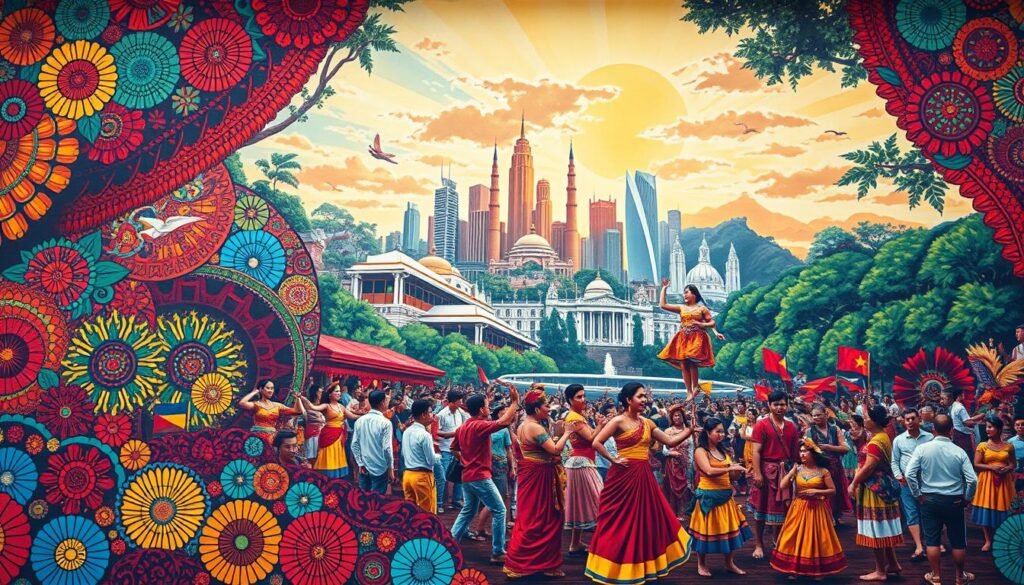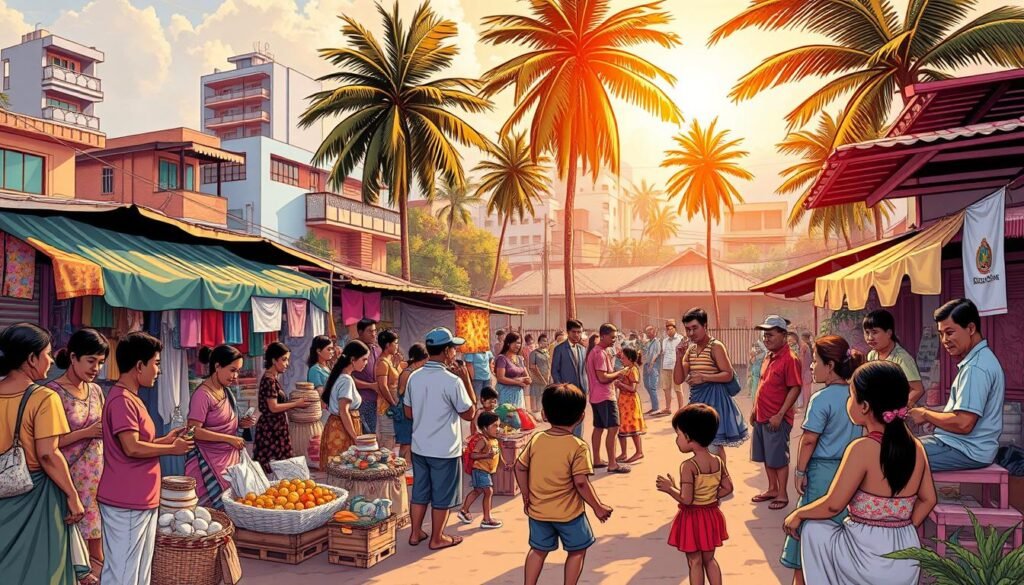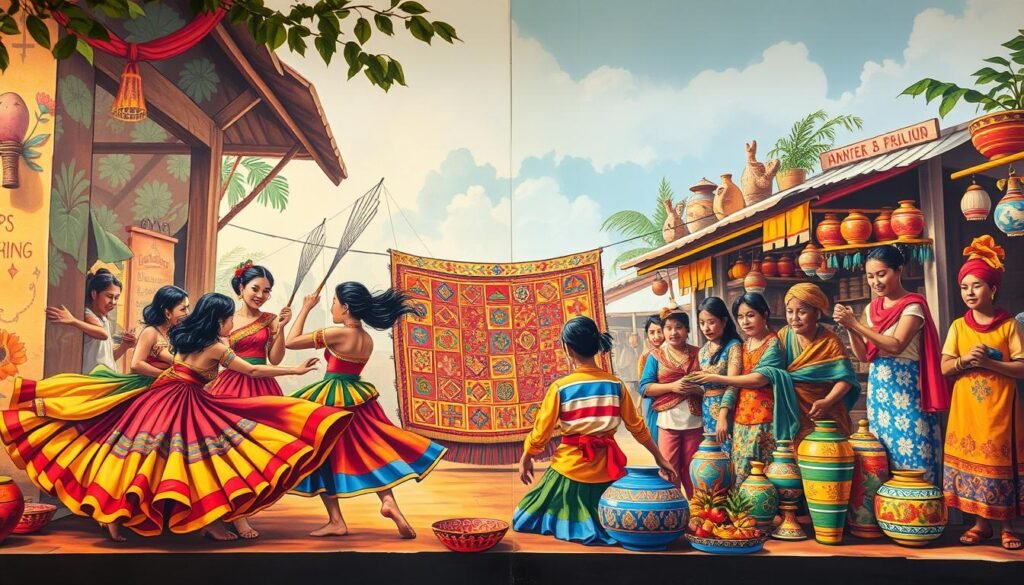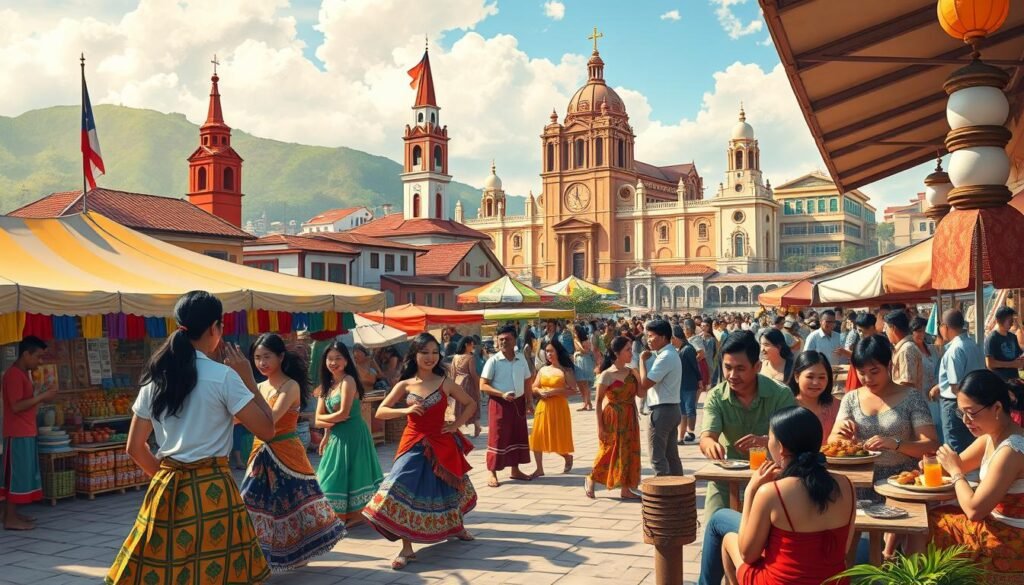Arts and culture play a vital part in defining who we are as a society. From traditional dances to modern paintings, these expressions help us understand our shared values and history. They act as a mirror, reflecting the essence of a nation’s identity.
In the Philippines, cultural heritage is deeply rooted in its diverse traditions. Festivals, music, and visual arts showcase the country’s unique identity. These forms of expression are not just art; they are a way to preserve and pass on collective memory.
Understanding the responsibility of arts in shaping identity is crucial. They inspire individuals and communities, fostering a sense of belonging. In a world of constant change, arts and culture remain a steady foundation for national pride.
Key Takeaways
- Arts and culture are essential in defining national identity.
- Traditional and modern expressions reflect societal values.
- Cultural heritage preserves collective memory.
- Arts inspire a sense of belonging in communities.
- The Philippines’ diverse traditions highlight its unique identity.
Exploring National Identity Through Arts and Culture
Through arts, societies preserve their unique stories and values. These cultural expressions are more than just creative outlets—they are the foundation of national identity. By understanding how arts and culture shape identity, we can appreciate their power in uniting communities and preserving heritage.

Defining National Identity and Heritage
National identity is the shared sense of belonging among a group of people. It is shaped by history, traditions, and cultural practices. According to sociological theories, heritage acts as a model for preserving these values. For example, the Cambridge English Corpus highlights how traditional narratives and rituals serve as a definition of cultural identity.
Art plays a part in this process by acting as a visual and emotional archive. From cave paintings to modern installations, art captures the essence of a society. As one study notes, “Art is not just a reflection of culture; it is a way to ensure its survival.”
Traditions and Societal Unity in the Philippines
In the Philippines, cultural traditions are a cornerstone of national identity. Festivals like Sinulog and Ati-Atihan showcase the country’s rich heritage. These events are not just celebrations—they are a way to reinforce shared values and foster unity.
Music and theater also play a vital role in this process. Traditional performances like the kundiman and sarswela tell stories of love, struggle, and resilience. These art forms connect people to their roots, creating a sense of belonging in a rapidly changing world.
“Cultural practices are the threads that weave a nation together.”
By preserving and promoting these traditions, the Philippines ensures that its identity remains vibrant and relevant. Arts and culture are not just a reflection of the past—they are a bridge to the future.
Understanding the Role in Society
Every society relies on defined roles to maintain order and unity. These roles act as guidelines for behavior, helping individuals understand their responsibility within the community. From family structures to professional settings, roles shape how people interact and contribute to societal stability.

The Social Role Framework and Expectations
Social roles are deeply rooted in cultural norms and expectations. They provide a model for how individuals should behave in different situations. For example, in many cultures, parents are expected to nurture their children, while teachers are seen as guides for learning.
These roles are not static. They evolve with societal changes, reflecting shifts in values and priorities. A person may take on multiple roles, such as being a parent, employee, and community leader, each with its own set of expectations.
Impact on Community Cohesion and Cultural Norms
Roles play a crucial part in fostering community cohesion. When individuals fulfill their roles effectively, it strengthens the collective spirit of the group. For instance, in the Philippines, the barangay system relies on leaders who act as mediators and problem-solvers, ensuring harmony within the community.
Cultural norms also influence how roles are defined. In some societies, gender roles are strictly defined, while others embrace more fluid interpretations. These norms shape the way people interact and contribute to the broader narrative of national identity.
| Role | Expectation | Impact on Society |
|---|---|---|
| Parent | Nurture and guide children | Strengthens family bonds |
| Teacher | Educate and inspire students | Promotes knowledge and growth |
| Community Leader | Mediate and solve conflicts | Ensures harmony and unity |
Understanding social roles helps us appreciate their significance in shaping society. They are not just expectations; they are the foundation of cultural identity and community cohesion.
Arts as a Model for Cultural Expression
The arts serve as a powerful medium for cultural expression, bridging the gap between tradition and modernity. They provide a way to explore societal values, identity, and heritage. Through creative performances and visual works, the arts act as a living archive, capturing the essence of a society’s collective memory.

Theatrical Influences and Actor Perspectives
Theater has long been a model for cultural expression, offering a platform to reflect societal roles and values. Actors, through their performances, bring stories to life, embodying the struggles and triumphs of their communities. For example, in the Philippines, traditional plays like the sarswela and kundiman highlight themes of love, resilience, and identity.
Prominent actors often use their craft to engage with pressing social issues. Their work not only entertains but also inspires audiences to reflect on their own position within society. As one actor noted, “The stage is a mirror where we see ourselves and our world more clearly.”
Role Models and Their Impact on Society
Artists and performers often become role models, influencing societal norms and inspiring change. Their responsibility extends beyond entertainment; they shape cultural narratives and foster unity. For instance, Filipino artists like Lea Salonga and Nora Aunor have used their platforms to advocate for social justice and cultural preservation.
These figures demonstrate how the arts can serve as a definition of cultural values. Their contributions remind us that artistic expression is not just a part of culture—it is the heart of it.
Performance as a Reflection of Cultural Values
Performance art, whether on stage or in public spaces, reflects the complexities of cultural identity. It serves as a wordless dialogue, conveying emotions and ideas that transcend language. In the Philippines, festivals like Sinulog and Ati-Atihan are vibrant examples of how performance art celebrates heritage and fosters community pride.
Artists often use their craft to mirror societal issues, creating works that challenge norms and provoke thought. As art as expression theory suggests, the creative process is an open-ended journey, where the final outcome is often unpredictable but deeply meaningful.
“Performance art is not just entertainment; it is a powerful tool for cultural preservation and social commentary.”
Through their work, artists and performers demonstrate the transformative power of the arts. They remind us that cultural expression is not just a team effort but a shared responsibility to preserve and celebrate our identity.
Influence of Culture on National Unity
Cultural traditions and social norms act as the glue that binds a nation together. They provide a definition of shared values and identity, fostering a sense of belonging among individuals. From festivals to daily practices, these elements shape the way people interact and contribute to societal harmony.

Cultural Traditions, Social Norms, and Educational Perspectives
Educational institutions play a vital role in preserving and promoting cultural heritage. Schools and universities serve as platforms where the younger generation learns about their roots and the importance of cultural responsibility. By integrating cultural education into curricula, these institutions help bridge generational divides and strengthen national unity.
Social norms also influence behaviors and expectations within a society. They create a framework for how individuals fulfill their jobs and interact as part of a larger team. For example, in the Philippines, the barangay system relies on community leaders to mediate conflicts and ensure harmony, reflecting the collective responsibility of its members.
“Cultural education is not just about preserving the past; it’s about building a shared future.”
Prominent cultural patterns, such as gender roles and professional expectations, further shape societal dynamics. These patterns highlight the role of culture in defining individual and communal identities. By understanding and respecting these norms, societies can foster inclusivity and mutual respect.
Cultural forces extend to various parts of society, reinforcing common values and strengthening unity. As highlighted in this study, fostering intercultural competence is essential for promoting national unity in diverse societies.
In the world of globalization, cultural traditions remain a steady foundation for national pride. They remind us that unity is not just a shared goal but a collective responsibility. By celebrating and preserving these traditions, nations can ensure that their identity remains vibrant and relevant for generations to come.
Conclusion
Arts and culture are the heartbeat of national identity, weaving together the past, present, and future. They reflect shared values and foster unity, creating a sense of belonging for every person. From traditional festivals to modern performances, these expressions remind us of our collective responsibility to preserve heritage.
In a rapidly changing world, cultural practices remain a steady anchor. They inspire individuals and communities, ensuring that identity stays vibrant and relevant. Educational institutions, like universities, play a key part in this by teaching the younger generation about their roots.
As we move forward, the role of arts and culture will continue to shape societies. They are not just a reflection of who we are but a guide for who we can become. By celebrating these traditions, we ensure that our identity remains strong for generations to come.
For more insights on crafting impactful conclusions, visit this guide.
FAQ
How do arts and culture shape national identity?
Arts and culture reflect a nation’s heritage, traditions, and values, helping to unify people and create a shared sense of belonging. They preserve history while inspiring pride and connection among citizens.
What is the importance of traditions in the Philippines?
Traditions in the Philippines strengthen societal unity by fostering cultural pride and continuity. They serve as a bridge between generations, preserving unique customs and values.
How does the social role framework impact communities?
The social role framework defines expectations and responsibilities within a community, promoting cohesion and stability. It helps individuals understand their contributions to societal norms and cultural practices.
What is the significance of role models in society?
Role models inspire individuals by embodying cultural values and achievements. They influence behavior, encourage positive change, and serve as examples of success and integrity.
How does performance reflect cultural values?
Performance, whether in theater or other arts, mirrors societal beliefs and traditions. It communicates stories, emotions, and cultural norms, offering insight into a community’s identity.
How do cultural traditions influence national unity?
Cultural traditions foster a sense of shared identity and purpose, bringing people together. They celebrate diversity while highlighting common values, strengthening national unity.
What role does education play in cultural preservation?
Education teaches cultural heritage and traditions, ensuring their continuity. It empowers individuals to appreciate and uphold their cultural identity, contributing to societal cohesion.
Source Links
- Microsoft Word – ACERP2018_39527.doc
- Cultural Nationalism | The Role of Culture in National Identity
- Art and Cultural Identity: Exploring the Intersections
- The Significance of Art in Revealing a Culture’s Identity and Multiculturalism
- Exploring cultural identities through art
- Social Roles and Social Norms In Psychology
- The Role of Anthropology in Understanding Culture and Society
- Arts and Culture in Global Development Practice: Expression, Identity and Empowerment
- Philosophy of art – Expression, Aesthetics, Creativity | Britannica
- Unity in diversity: navigating global connections through cultural exchange
- Conclusions – The Writing Center • University of North Carolina at Chapel Hill
- How to Write a Conclusion for an Essay | BestColleges
- Discussion vs Conclusion: What is the Difference? | Researcher.Life

